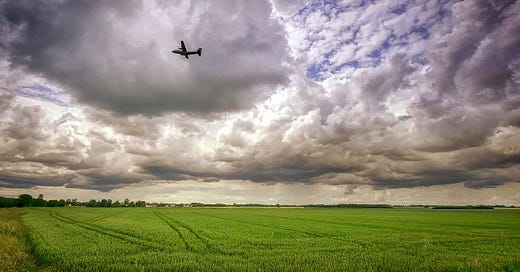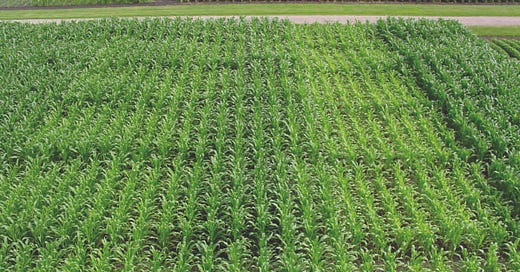

Discover more from Ag Data News
Policymakers and airlines are looking for ways to reduce the carbon footprint of air travel, and with good reason. Flying a mile in a commercial jet emits about 40% as much carbon dioxide per passenger as driving a mile by yourself in a typical car1. This means a family of three generates more emissions if they fly to their vacation spot than if they drive.
Commercially viable battery or fuel-cell airplanes do not yet exist and likely won't exist for a long time, so the focus has turned to liquid biofuels known as Sustainable Aviation Fuels (SAF). SAFs are liquid jet fuels produced from plant biomass, waste products, vegetable oils, or ethanol.
The Biden administration has issued a grand challenge that aims to increase production of SAF from 16 million gallons to three billion gallons by 2030. That's a massive increase and meeting it will require a lot of land. This week, UC Davis PhD student Andrew Swanson and I published an short article in AEI Seasonal Harvest on the amount of land required to mee this challenge.
I provide a brief summary of the article below, but you really should just go read it for yourself.
SAFs are liquid hydrocarbons, so they do not require major modifications to current jet engines or fueling infrastructure. Two feasible ways to produce SAFs are:
Alcohol to Jet (AtJ). Remove oxygen from ethanol and link the remaining molecules together to obtain jet-fuel chain length,
Hydrotreated Esters and Fatty Acids (HEFA). Use hydrogen to remove oxygen from vegetable oils and crack the remaining molecules to jet-fuel chain length.
In the United States, AtJ production would rely on ethanol made from corn and HEFA would use soybean oil.
We demonstrate in our article that if crop yields continue their historical trends, then growing soybeans to produce three billion gallons of SAF would require 41.4 million acres, whereas using corn would require 9.1 million acres. The required amount of land is higher if yield rends decelerate and lower if yield trends accelerate. Using soybeans as a SAF feedstock would require more than four times as much land as would corn because soybean yields are much lower than corn yields.

For context, in 2022, American farmers planted 79 million acres of corn, of which 27 million went into ethanol for cars. They planted 86 million acres of soybeans, of which 21 million went into biomass-based diesel for trucks, trains, and tractors.
These calculations do not include the value of by-products from SAF production. A third of each bushel of corn that goes into an ethanol plant becomes distillers grain, which can be used for animal feed. Similarly, about 80% of each bushel of soybeans become meal that can be used for animal feed.
We are not predicting that farmers would expand cropland by 9.1m acres if the SAF grand challenge were to be met with SAF from corn ethanol. They may instead plant less of other crops, or consumption of corn by cars or livestock may decrease to make more corn available for SAF. The same goes for soybean oil for SAF.
However, any cropland expansion caused by SAF would severely undermine the potential greenhouse gas emissions reductions from these fuels, as shown in this 2022 paper that I co-authored. Converting land to crops releases carbon from the soil and reduces biomass.
The Inflation Reduction Act provides a tax credit of between $1.25 and $1.75 for SAF producers, but only if their fuel reduces greenhouse gas emissions by 50% relative to petroleum jet fuel. This tax credit will play an important role in driving SAF expansion. Andrew explains in this farmdoc daily article that it is not yet clear whether corn ethanol will qualify for the SAF tax credit; whether it qualifies will be determined by modeling and policy decisions to be made in the Treasury Department.
Severin Borenstein estimates that an average commercial flight across the United States emits about 860kg of carbon dioxide per passenger over 5400 miles, or 160 grams per mile. EPA estimates that a typical passenger car emits 400 grams per mile, and 160/400=40%













